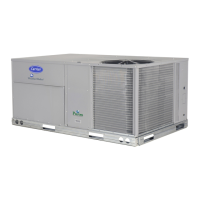47
basepan. Pull correctly rated high voltage and low voltage
through appropriate conduits. Connect the power conduit to the
internal disconnect (if unit is so equipped) or to the external
disconnect (through unit side panel). Remove one of the two
knockouts located on the bottom left side of the unit control
box. Use this hole for the control conduit.
Fig. 71 — Thru-the Base Option, Shipping Position
(Size 16)
Fig. 72 — Installing Thru-the Base Option (Size 16)
Units Without Thru-base Connections
1. Install power wiring conduit through side panel openings.
Install conduit between disconnect and control box.
2. Install power lines to terminal connections as shown in
Fig. 63.
Field Control Wiring
The 50TC-16D unit requires an external temperature control de-
vice. This device can be a thermostat (field-supplied) or a Pre-
mierLink™ controller (available as factory-installed option or as
field-installed accessory, for use on a Carrier Comfort Network
®
or as a stand alone control) or the RTU Open Controller for
Building Management Systems using non-CCN protocols (RTU
Open controller is available as a factory-installed option only).
Thermostat
Select a Carrier-approved accessory thermostat. When electric
heat is installed in the 50TC unit, the thermostat must be capa-
ble of energizing the G terminal (to energize the Indoor Fan
Contactor) whenever there is a space call for heat (energizing
the W1 terminal). The accessory thermostats listed on the unit
price pages can provide this signal but they are not configured
to enable this signal as shipped.
Install the accessory thermostat according to installation in-
structions included with the accessory.
Locate the thermostat accessory on a solid wall in the condi-
tioned space to sense average temperature in accordance with
the thermostat installation instructions.
If the thermostat contains a logic circuit requiring 24-v power,
use a thermostat cable or equivalent single leads of different
colors with minimum of seven leads. If the thermostat does not
require a 24-v source (no “C” connection required), use a ther-
mostat cable or equivalent with minimum of six leads. Check
the thermostat installation instructions for additional features
which might require additional conductors in the cable.
For wire runs up to 50 ft (15 m), use no. 18 AWG (American
Wire Gage) insulated wire (35°C minimum). For 50 to 75 ft
(15 to 23 m), use no. 16 AWG insulated wire (35°C minimum).
For over 75 ft (23 m), use no. 14 AWG insulated wire (35°C
minimum). All wire sizes larger than no. 18 AWG cannot be
directly connected to the thermostat and will require a junction
box and splice at the thermostat.
Fig. 73 — Typical Low-Voltage Control Connections
(Size 16)
Unit without Thru-Base Connection Kit
Pass the thermostat control wires through the bushing on the
unit end panel. Route the wire through the snap-in wire tie and
up to the web bushing near the control box. Route the wire
through the bushing and into the bottom left side of the control
box after removing one of the two knockouts in the corner of
the box. Using a connector at the control box to protect the
wire as it passes into the control box. Pull the wires over to the
terminal strip at the upper left corner of the Central Terminal
Board (CTB). Use the connector at the control box and the
wire tie to take up any slack in the thermostat wire to ensure
that it will not be damaged by contact with the condenser coil.
See Fig. 74.
NOTE: If thru-the-bottom connections accessory is used, refer to
the accessory installation instructions for information on routing
power and control wiring.
1
/
2
” ELECTRICAL
BULKHEAD
CONNECTOR
1
1
/
2
” ELECTRICAL
BULKHEAD
CONNECTOR
GASKET
CONNECTOR
PLATE
ASSEMBLY
X
C
G
W2
C
W2
G
W1
O/B/Y2
Y2
R
W1
R
Y1
Y1
T
H
E
R
M
O
S
T
A
T
(Note 1)
(Note 2)
Note 1: Typical multi-function marking. Follow manufacturer’s configuration
instructions to select Y2. Do not configure for O output.
Note 2: W2 connection not required on units without electric heating.
Field Wiring
Central
Terminal
Board
Typical
Thermostat
Connections

